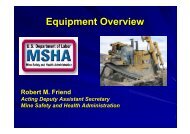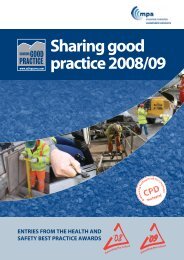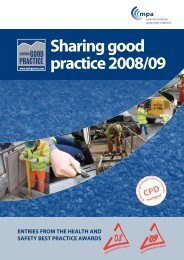Download PDF (2.3MB) - Safequarry.com
Download PDF (2.3MB) - Safequarry.com
Download PDF (2.3MB) - Safequarry.com
Create successful ePaper yourself
Turn your PDF publications into a flip-book with our unique Google optimized e-Paper software.
Manual handling improvements<br />
Tarmac Northern > 0191 492 4000<br />
manual handling & storage: 63<br />
Tarmac Northern’s North Area (Concrete & Mortar) has taken the following initiatives to reduce risks<br />
associated with manual handling:<br />
• a decision has been taken to ban the use and ordering of materials stored in 205 litre drums, with bulk<br />
tanks put in place to ac<strong>com</strong>modate additional products<br />
• a mobile conveyor was purchased to facilitate the addition of steel fibres into the production process or<br />
truck mixer<br />
• further development work has continued with the truck mixer admixture dispenser and the dispenser<br />
will soon be available throughout the industry<br />
• liquid pigments are now in use at both mortar factories, replacing bagged powder pigments, which<br />
created an ‘at risk’ activity due to their size and production methods in producing coloured mortar.<br />
><br />
Drum lifting mechanised<br />
CEMEX UK > Powburn Quarry, Northumberland > 01665 606061<br />
Around ten miles west of Alnwick is Powburn Quarry, belonging to CEMEX. Full 205 litre oil drums,<br />
weighing 185kg each, do not now present a manual handling risk at Powburn. The fitting in the roof of<br />
the oil store of three fixed channels supporting a travelling lifting beam (which can move side to side, on<br />
runners) has provided an ideal solution. The beam extends outside the store. The lifting tackle is fitted<br />
with purpose-designed drum-lifting tongs.<br />
><br />
Safer storage of bottled gas<br />
Foster Yeoman > Crawley Depot, West Sussex > 01293 538669<br />
Foster Yeoman’s Crawley Depot has devised a method of<br />
preventing the potential for cross-contamination caused<br />
by storing different types of gas bottles in a single cage.<br />
By making the cages to suit the size of the bottles, with a<br />
fixed sized entrance gate at the opening of each cage, the<br />
<strong>com</strong>pany was able to reduce the risk of potential hazards<br />
with minimal cost – as the entrance gates were actually<br />
made from off-cuts of steel that were already on site.<br />
Each cage was split into two halves, with one side for<br />
empties and the other for full gas bottles. Warning signs<br />
were attached to front of cages and the cage floors were<br />
constructed of galvanised steel on a concrete surface to<br />
allow good drainage and prevent bottles and cages from rusting.<br />
The roofs of the cages are made from tepee-shaped galvanised steel to keep weather from penetrating<br />
bottles and the sides are mesh to allow for good ventilation. All cages can be padlocked and the keys are<br />
held by authorised personnel only.













